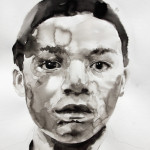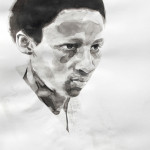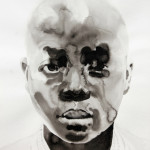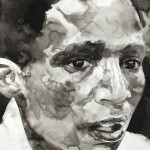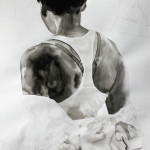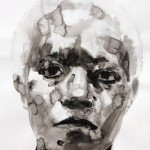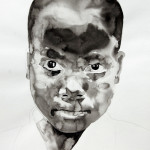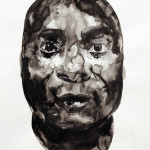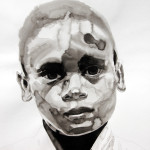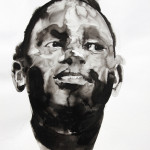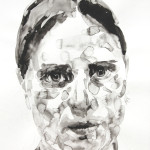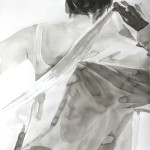The following is an unedited exchange between painters Nigel Mullins and Tanya Poole:
NM: You were born in Canada, left when you were three, then spent time in the UK and Bahrain, and arrived in Pretoria, South Africa in 1981 when you were ten. I know these formative years are very important to you. What do you keep within you from this time and what was it like to come to South Africa? Your teenager-hood in South Africa in the 80’s in places like Pretoria, Vereeniging and Benoni, obviously was very formative. Can you trace any influence from these years on your work?
TP: Coming to South Africa was very difficult and a bit traumatising. I’d come from a background of liberal education and progressive thinking to a deeply conservative society which was racially segregated and oppressive. In Bahrain we lived in a multi-racial compound. In South Africa, anyone non-white was treated with disdain and often cruelty. Sexism was deeply ingrained. People’s mind-sets here in South Africa were very different to what I knew and how I thought. An oppressive regime held people’s thoughts so tightly and fearfully that there seemed no possibility of change. I hated it and I was frightened by it. I wouldn’t have been able to formulate much more than this as a little girl, a lot of my understanding of this has been in hindsight. My family were very stable, though – protective and fun and loving. I can see these experiences and my reactions to them coming through in the person I am now and in the approach to my work.
NM: Your new Exhibition Thozama and Rose at Galerie m Bochum, in Germany opens in September this year. Your work has tended to look closely at the dynamics of people close to you, but this new exhibition looks at the wider complexity of South African social structure. Could you comment on this?
TP: It’s true that I’m drawn by the dynamics between people, I like the metaphor for a wider social dynamic. And this is certainly true of Thozama and Rose. In them I see a microcosm, through which we can extrapolate some of the difficulty of relationships that we see and are a part of all the time in South Africa. To Non-South Africans it may seem very strange, and rightly so. The legacy of the past still holds social relationships in a tight fist. Apartheid left terrible devastation and it’s going to take many generations to equalise the inequality that it manufactured. Nobody here lives without the imprint of it yet. But it is changing.
When I was in my 30s and had a 3 year old daughter, I decided to take up karate. It’s been an abiding love since then and I hold a second Dan black belt. My fascination with the dojo is that it exists in a social bubble. The rules and social conventions and constructs and statuses that exist outside the dojo don’t exist in the dojo. An entirely different set of rules and hierarchies play out in the dojo. The things that seem to separate us out outside the dojo – class, age, race, gender, religion, profession – have no bearing in the dojo, and in fact are often subverted. Through the lens of the hierarchy of the dojo, which is a particularly manufactured system, one can be more aware of the social and political structures that one is part of, in one’s time, in one’s country, in one’s community and how manufactured these are. The only difference is that one chooses to accept the dojo system, but one doesn’t choose into which system one is born and in which one lives.
Last year, two women came into the dojo to start karate – Thozama and Rose. They came with a young boy, Rose’s son, and all three of them joined my class. After a few weeks, the boy decided it wasn’t for him, and left. The women stayed. They became stronger, more confident. I learned that Rose was a PhD at Rhodes University, in the science faculty and that Thozama was employed by Rose as a nanny to her children, and that Thozama had another job besides. I watched them start to grow as karateka – Rose strengthening and losing self-consciousness, and Thozama becoming more fierce and fiery – and I saw that they carried their histories with them. They worked together as partners, punching and kicking and blocking each other, developing with each other as fighters, and I watched their already existing friendship bloom in new ways and in new understandings of each other’s characters and weaknesses and strengths.
I realised that I wanted to work with what I was seeing, that I could sense and try to focus on the subtleties of expression in their faces and body language, where this slipped between ‘outside’ social gestures and where it took on a karate language. I asked them if they’d be willing to let me document them in a training session which led up to a fight, and cooled down after, which they agreed to. I documented this through stills and video footage, which I worked from in my paintings. Karate can be an awkward process, especially as an adult, especially as a woman. It’s unusual to see adult women fight physically. We layer loads of socialised facial and body expressions over our fear and embarrassment and apologies, but those masks slip when we are faced with difficult, uncomfortable or threatening situations, like a physical confrontation.
NM: To my mind, you have mastered black ink on paper. The confidence, accuracy and unexpectedness of the mark making, give the new works an almost claustrophobic intimacy. Tell us about ink.
Ink is a wonderful medium. It is less certain and more certain than oils. It is more certain because when one puts in down on paper, it stains and stays – it doesn’t have the malleability of oils to cover and reform. It is less certain because it flows where it wants and one has limited control over that. A well formed face, for example could be marred by a settling of the ink into the warping paper, like a wound or a rupture on the skin. I had started working with inks after a bad shoulder injury from being thrown in karate – I couldn’t lift my arm properly, so easel painting was out, but working down onto horizontal paper was in. I found a sympathy and tension in painting fighters from my club in ink because of the ink’s properties as a delicate medium – I felt I could convey the subtleties of gesture and expression better. Oils would have matched the dynamism and muscularity of fighters, but I didn’t want a match, I wanted a subversion. Ink was my first choice for Thozama and Rose too. With colour leached from the process, I felt I could pare down the excess of heat and dynamic of quick, strong, explosive physicality and leave bare the tremulousness of their emotional process
As if the complexity of race and gender stereotyping and social systems wasn’t enough, I had questions about my privileged view as a white South African, as the sensei and as the artist. I decided to paint an audience and include myself in it. I painted the portrait, in ink, on 65 x 50cm sheets of paper, of every karateka in my club, in the line up they are in when they bow to me (and me to them) at the beginning and the end of each class. This is a strict hierarchical arrangement with the most junior white belts to my right and the higher belts to the left, and they constitute The Audience who witness the interaction between Thozama and Rose. They are positioned on the wall opposite Thozama and Rose and are installed in their belt ranks They are a similar device to that of the Chorus in ancient Greek theatre pieces. The Audience doesn’t resolve my issues, but it does point to the complications inherent in them. The viewer, standing in the middle of the gallery, may also feel that they are standing in the space of the dojo, which I hope will not feel comfortable.
I hope this goes to explaining the work and the process behind it. I’ve selected some of the paintings of Thozama and Rose that show aspects of the transitional process they went through. Thozama, changing and Rose, changing show them changing into their gis (karate suits) and making the transition from the outside world to the space of the dojo. For me, it’s a little like watching them putting their armour on and catching a glimpse of the vulnerable body beneath in the intimate space of the changing room – a room in which to change from one set of rules to another. Thozama, before and Rose, before are portraits of the women before they start their session. In these they carry to some extent the masks of social etiquette. In Thozama, after and Rose, after, they are both exhausted – physically and mentally – after the fight. The difference is quite marked and the faces more naked.
I have also included, for this interview, a small selection of the members of The Audience – the older karateka from a pre-1994 generation, and younger karateka, the born-frees, who are the witnesses that take us into our next generation.
Tanya Poole is an artist and a senior lecturer in Fine Art at Rhodes University and heads the Painting Section. She graduated in 1999 with an MFA from Rhodes University. Exhibiting in South Africa, the UK, Germany, The States, Austria and Iceland, Poole has had 13 solo shows and participated in 31 group shows. Most recently, she has exhibited Thozama and Rose at Galerie M Bochum in Germany, an exhibition of ink on paper works and filmic pieces. She has also recently had her oil paint animation work D/rift included in U/Tropia, curated by Brent Meistre and Daniel Ebner at the Vienna Art Fair (Wien Festwochen) in Austria. Poole was born in St John’s, Newfoundland, and was raised in Bahrain in the Middle East, the UK and South Africa. She currently lives in Grahamstown, South Africa, with her husband Nigel Mullins and their daughter, Sophie.
